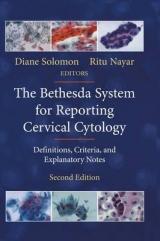
The Bethesda System for Reporting Cervical/Vaginal Cytologic Diagnoses
Definitions, Criteria and Explanatory Notes for Terminology and Specimen Adequacy
Seiten
1997
|
New edition
Springer-Verlag New York Inc.
978-0-387-94077-9 (ISBN)
Springer-Verlag New York Inc.
978-0-387-94077-9 (ISBN)
- Titel erscheint in neuer Auflage
- Artikel merken
Zu diesem Artikel existiert eine Nachauflage
The Bethesda system for reporting cervical/vaginal cytologic diagnoses was developed to provide uniform diagnostic terminology that would facilitate communication between the laboratory and the clinician. The format of The Bethesda System report includes a descriptive diagnosis and an evaluation of specimen adequacy.
THE BETHESDA SYSTEM FOR REPORTING CERVICAL/VAGINAL CYTOLOGIC DIAGNOSES was developed at a National Cancer Institute sponsored workshop in December 1988 to provide uniform diagnostic terminology that would facilitate communication between the laboratory and the clinician. The format of The Bethesda System report includes a descriptive diagnosis and an evaluation of specimen adequacy. The Bethesda System we designed to be flexible in order that it could evolve in response to changing needs in cervical cancer screening as well as to advances in the field of cervical pathology. Subsequently, a second workshop was held in April 1991 to evaluate the impact of The Bethesda System in actual practice and to amend and modify it where needed. One of the major recommendations of this second meeting was that precise criteria should be formulated for both the diagnositic terms and for the descriptors of specimen adequacy. That is the intended purpose of this report.
THE BETHESDA SYSTEM FOR REPORTING CERVICAL/VAGINAL CYTOLOGIC DIAGNOSES was developed at a National Cancer Institute sponsored workshop in December 1988 to provide uniform diagnostic terminology that would facilitate communication between the laboratory and the clinician. The format of The Bethesda System report includes a descriptive diagnosis and an evaluation of specimen adequacy. The Bethesda System we designed to be flexible in order that it could evolve in response to changing needs in cervical cancer screening as well as to advances in the field of cervical pathology. Subsequently, a second workshop was held in April 1991 to evaluate the impact of The Bethesda System in actual practice and to amend and modify it where needed. One of the major recommendations of this second meeting was that precise criteria should be formulated for both the diagnositic terms and for the descriptors of specimen adequacy. That is the intended purpose of this report.
Part One: Specimen Adequacy: Definitions, Criteria, and Explanatory Notes; 1. Beackground; 2. Definitions and Criteria for Specimen Adequacy; Part Two: Descriptive Diagnoses: Definitions, Criteria, and Explanatory Notes; 1. Benign Cellular Changes; 2. Epithelial Cell Abnormalities; 3. Low-grade Squamos Intraepithelial Lesion (LSIL); 4. High-grade Squamos Intraepithelial; 5. Glandular Cell; 6. Other Malignant Neoplasms.
| Zusatzinfo | 61col.ill. |
|---|---|
| Verlagsort | New York, NY |
| Sprache | englisch |
| Themenwelt | Medizin / Pharmazie ► Medizinische Fachgebiete ► Gynäkologie / Geburtshilfe |
| Medizin / Pharmazie ► Medizinische Fachgebiete ► Onkologie | |
| ISBN-10 | 0-387-94077-4 / 0387940774 |
| ISBN-13 | 978-0-387-94077-9 / 9780387940779 |
| Zustand | Neuware |
| Informationen gemäß Produktsicherheitsverordnung (GPSR) | |
| Haben Sie eine Frage zum Produkt? |
Mehr entdecken
aus dem Bereich
aus dem Bereich
Buch | Hardcover (2024)
Urban & Fischer in Elsevier (Verlag)
CHF 129,95
alles für Station, Praxis und Facharztprüfung
Buch (2023)
Thieme (Verlag)
CHF 229,95



